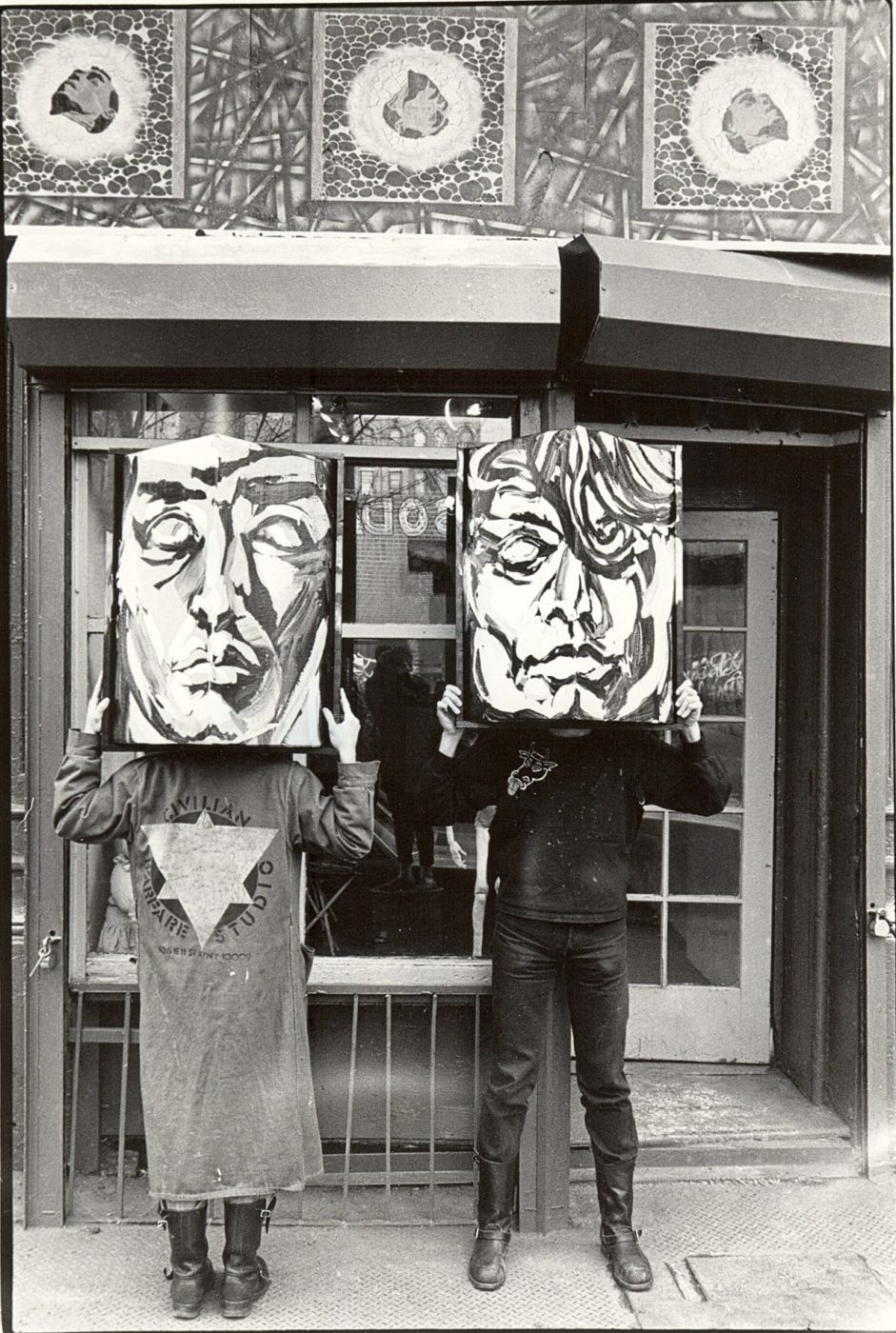The Civilian Warfare Gallery: Artists in Combat
Founded by artists and partners Alan Barrows and Dean Savard in 1982, Civilian Warfare is one of the most under-interpreted yet incredibly influential galleries in the East Village’s art scene. Barrows and Savard started the gallery during the height of the Regan Era and the HIV/AIDS Crisis, when the East Village was plagued by rampant substance abuse, cycles of poverty, mountains of garbage, and burned out cars. In Barrow’s eyes, it resembled a war zone. It was in this dark setting that one of our neighborhoods’ brightest artistic incubators was started at 526 East 11th Street, between Avenues A and B.


Photos Above: Alan Barrows and Dean Savard in Front Of Civilian Warfare Gallery in 1984. Photographs by Marion Scemama. Photographs are unedited. Copyright 2016: All rights reserved Alan Barrows WGA #1855035
The story goes that Savard was walking along 11th Street and 2nd Avenue in 1982 when he noticed a disheveled woman standing on top of a milk crate proclaiming, “The Russians are coming and it’ll be f***ing civilian warfare in the streets of New York!” Figuring her speech embodied the mindset of the neighborhood, he named his new art gallery after it.
Barrows and Savard created the Civilian Warfare Gallery as a live/work studio, supporting individual artists and combating cultural stigmas against LGBTQIA+ individuals, the impoverished, and those affected by substance abuse. The couple helped to launch the careers of now well-known artists like David Wojnarowicz, Richard Hambleton (creator of “Shadowman), Luis Frangella, the Grey Organisation/Toby Mott and Jane Bauman, among many others. In his blog, Barrows remarked that his intent was to promote “thought-provoking art that gave artists the freedom to express what they were experiencing.” It was here that trans artist Greer Lankton exhibited her anthropomorphic dolls that commented on society’s views of the human body and its presentation within the confines of gender. They also provided refuge for artists like Judy Glatzman, whose exhibition of contemporary paintings was removed from the Citicorp headquarters after an employee complained.


Photo Left: Civilian Warfare Gallery opening for David Wojnarowicz’s one-man show in 1984. Photograph by Andres Sterzing. Photo Left: Poster invitation for Wojnarowicz’s show at the gallery. The photo is by Marion Scemama while in David’s studio on the Bowery. David is surrounded by the plaster heads used for the Metamorphosis Series (1984) Photographs are unedited. Copyright 2016: All rights reserved Alan Barrows WGA #1855035
But the gallery’s role as an under-the-radar incubator wouldn’t last long. New York Times columnist Grace Glueck featured the gallery in her article, ”Gallery View: A Gallery Scene that Pioneers in New Territories,” (originally published in the Sunday edition, June 26th, 1983), which explored the East Village’s galleries as a flashier and highly politicized foil to the SoHo and Uptown art scenes. Glueck describes the gallery and its then-new exhibition of Wajnarowicz’s work as “violent, erotic, and political, [featuring] stirring images painted over supermarket food posters, on garbage can lids, found pieces of metal and other materials [that] seem right at home in the gritty street ambiance that surrounds them.”

Photo Above: Grace Glueck’s “Gallery View: A Gallery Scene that Pioneers in New Territories” in The New York Times (June 26th, 1983)
Despite Glueck’s slightly patronizing tone, the article was a hit, and Barrows described that “all hell broke loose after that story ran [, and] Stretch limos started showing up with the occupants snapping up artwork that would end up in the collections of some of the most prestigious museums in the world.” The gallery became the setting of fabulous openings, heavily participating in the East Village’s party scene. Unfortunately, the star-struck gallery burned too bright, and Barrows and Savard ended their gallery’s short run in 1987 after several of their friends and collaborators succumbed to the twin HIV/AIDS and narcotic/opioid crisis.
If you’d like to learn more about sites important to Contemporary Art and LGBTQIA+ heritage in the East Village, then we’d encourage you to explore our East Village Building Blocks website and its guided tours.
Sources Cited for this Blog:
- Grace Glueck ‘s “Gallery View; A Gallery Scene that Pioneers in New Territories” for The New York Times’ June 26th Sunday Edition
- Alan Barrow’s “Civilian Warfare Gallery” blog, published in 2016.
